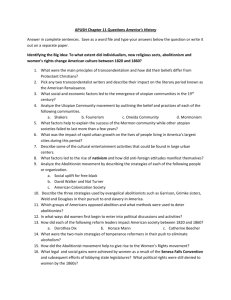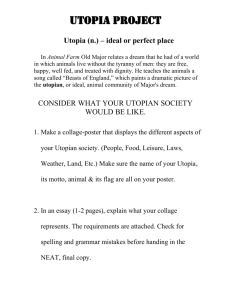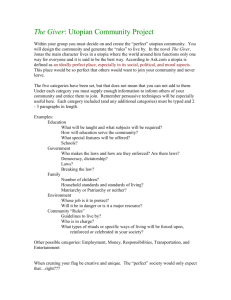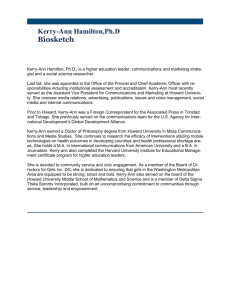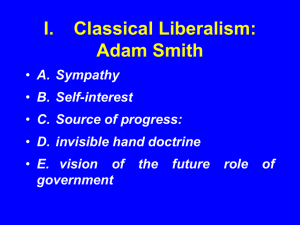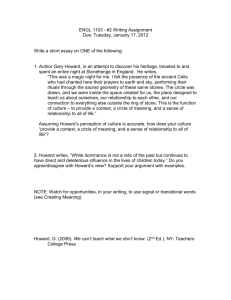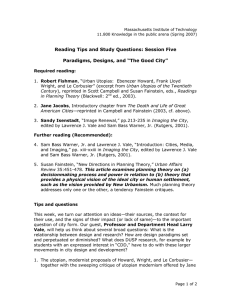11.800, Knowledge in the Public Arena: The Uses and Abuses... Professors Xavier de Souza, Frank Levy, and Martin Rein
advertisement
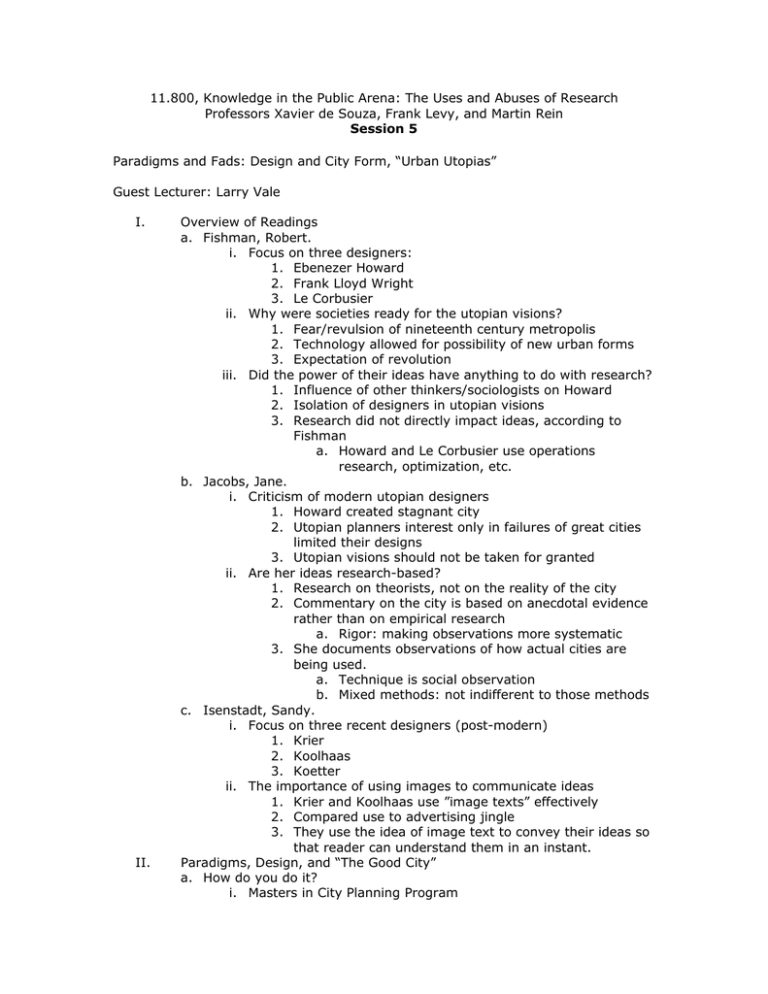
11.800, Knowledge in the Public Arena: The Uses and Abuses of Research Professors Xavier de Souza, Frank Levy, and Martin Rein Session 5 Paradigms and Fads: Design and City Form, “Urban Utopias” Guest Lecturer: Larry Vale I. II. Overview of Readings a. Fishman, Robert. i. Focus on three designers: 1. Ebenezer Howard 2. Frank Lloyd Wright 3. Le Corbusier ii. Why were societies ready for the utopian visions? 1. Fear/revulsion of nineteenth century metropolis 2. Technology allowed for possibility of new urban forms 3. Expectation of revolution iii. Did the power of their ideas have anything to do with research? 1. Influence of other thinkers/sociologists on Howard 2. Isolation of designers in utopian visions 3. Research did not directly impact ideas, according to Fishman a. Howard and Le Corbusier use operations research, optimization, etc. b. Jacobs, Jane. i. Criticism of modern utopian designers 1. Howard created stagnant city 2. Utopian planners interest only in failures of great cities limited their designs 3. Utopian visions should not be taken for granted ii. Are her ideas research-based? 1. Research on theorists, not on the reality of the city 2. Commentary on the city is based on anecdotal evidence rather than on empirical research a. Rigor: making observations more systematic 3. She documents observations of how actual cities are being used. a. Technique is social observation b. Mixed methods: not indifferent to those methods c. Isenstadt, Sandy. i. Focus on three recent designers (post-modern) 1. Krier 2. Koolhaas 3. Koetter ii. The importance of using images to communicate ideas 1. Krier and Koolhaas use ”image texts” effectively 2. Compared use to advertising jingle 3. They use the idea of image text to convey their ideas so that reader can understand them in an instant. Paradigms, Design, and “The Good City” a. How do you do it? i. Masters in City Planning Program b. How do you criticize it? i. History, Theory, and Criticism in Architecture c. How do you situate design in the larger set of social, political, economic, and environmental forces at work in cities? i. Doctoral program: how can design be a diagnostic tool to explore social science questions 1. Design as a sneaky form of knowledge 2. Design as restraining or affording human possibility in revealing ways. 3. Questions: a. How and where are processes encoded in design and the built environment? i. CDD faculty: where public policy and design intersect; infrastructure standards; how natural systems intersect; b. Can you design better cities? i. Who is the you? ii. Better in terms of what kinds of paradigmatic values? iii. What are the intellectual and spatial boundaries of ‘city’. c. People who make arguments about social relationships through design d. People who make arguments through criticizing those who make arguments about social relationships through design. 4. Designers: a. Critiques of society through the mechanism of design b. Moderists: i. Ebenezer Howard 1. Garden Cities of Tomorrow, 1902 2. Stark analysis of problems of town life and country life 3. How can the good elements of the town be blended with the good elements of the country? 4. Within circle: walkable community with public infrastructure and schools, full set of jobs, etc., factories on the outer edge a. The idea of separating land uses is being invented in this plan 5. Ideas influencing the world: a. Letchworth, Unwin and Parker i. Shift away from diagram ii. Somewhat dense iii. Beginning of regional planning b. Welwyn Garden City 6. Jacob’s Criticism: a. City sorted into selfcontained uses b. Housing as primary and suburban c. Plan as static and complete d. Planning as paternalistic ii. Le Corbusier 1. Critique of city: growing in most uninteresting, monotonous, crowded ways 2. “A city made for speed is made for success” 3. The Contemporary City: ground plane for movement, light, air, energy, etc. a. How do you fill in the empty space? b. How does it get used? 4. Voisin Plan for Paris: a. Large skyscrapers and major arterial roads b. Research sponsored by the Voisin car company 5. La Ville Radieuse (the Radiant City): a. Final version of the plan b. Design of segregation of classes c. Primacy of automobile traffic 6. Complete social hierarchy expressed spatially a. Radical reorganization of society 7. Power a. Sought powerful political regimes to sponsor his work i. Nehru, India: Chandighar 8. Jacobs Critique: a. High density version of previous problems b. Super-block and ‘project neighborhood’ c. Unchangeable plan d. Empty open space e. Kept pedestrians off the street and in parks 9. Research Base a. 1929 New York Regional Plan study of building spacing for winter solstice b. Studies of building heights vs. spacing c. Diagram of children killed by street vehicles in 1926 d. Analysis of development costs c. City Beautiful i. Daniel Burnham 1. Columbian Exposition, Chicago, 1893, “The White City” 2. Grand, aesthetically driven, axial plan 3. Revival of L’Enfant plan for Washington by McMillan a. Rationalization of the axis of the Mall i. Re-centering on the Lincoln Memorial 4. Jacob’s critique a. Sorting out monuments from the city ii. Frank Lloyd Wright 1. Brasilia: designed by people who worked with him a. “Authoritarian High Modernism” b. Relationship of formal order and informal processes 2. Embraces individuality, randomness of markets 3. Broad Acre City: a. Mix of farmland, orchards, shopping malls, premised on each person having a private automobile. b. Gasoline delivered to home c. Houses labeled by number of cars d. Rational advocacy for sprawl e. All pieces of city should be spread across entire countryside d. New Urbanism: i. Krier 1. Anti-modernist backlash 2. The Good City = city with intertwined public and private realms 3. The Problem = the industrial anticity split everything into zones that require a car to traverse. 4. Vertical zoning vs. horizontal zoning 5. Poundbury, UK a. Complete mockup of a neoGeorgian town according to his principles ii. New Urbanism 1. Term emerged in 1990s to describe neo-traditional building processes 2. Code for allowable building types a. Specifies style, set backs, etc. 3. Rational, research-based attempt to bring urban elements back to town building 4. Examples: a. Seaside, FL b. Kentlands, MD c. King Farm, MD d. Celebration, FL e. Koolhaas i. Celebrating dynamism, juxtaposition, and flows. ii. Constrained individuality 5. Boston West End Plan, 1950s a. Who decides what is “obsolete” and based on what data? b. Gans, The Urban Villagers, explores the value of the West End based on rich ethnographic data, completely invisible to bankers, lenders i. Socio-economic vs. ethnographic arguments ii. Jacobs critique of tendency to ignore research and knowledge of scholars like Gans. ii. Conclusion 1. Understanding the social implications of design 2. Important to understand economic/social relationships at a spatial level 3. Using design as a diagnostic tool for understanding social relations within cities.
